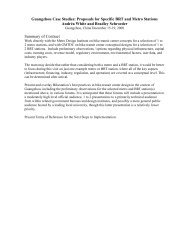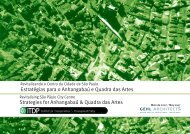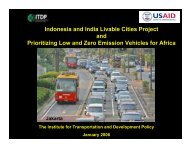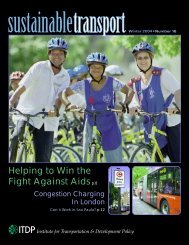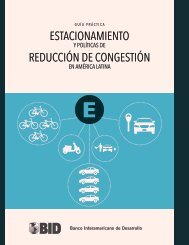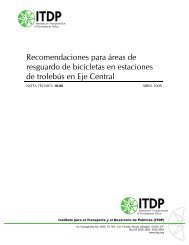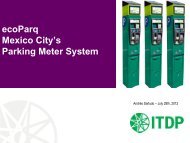Annual Report - ITDP | Institute for Transportation and Development ...
Annual Report - ITDP | Institute for Transportation and Development ...
Annual Report - ITDP | Institute for Transportation and Development ...
Create successful ePaper yourself
Turn your PDF publications into a flip-book with our unique Google optimized e-Paper software.
PUBLIC TRANSPORT<br />
<strong>ITDP</strong> completed a report on CO2 emissions<br />
reductions resulting from China’s Guangzhou<br />
BRT, which showed that Guangzhou’s BRT<br />
will reduce more emissions than any other<br />
BRT system in the world, an average of 86,000<br />
tonnes of CO2 per year over its first ten years<br />
of operations, <strong>for</strong> a yearly CER value of 19<br />
million yuan. The impact of the BRT system<br />
goes beyond emissions reductions in Guangzhou.<br />
The system is serving as a model <strong>for</strong><br />
the rest of Asia by demonstrating the viability<br />
of metro-scale BRT <strong>and</strong> the potential costeffectiveness<br />
of urban transport.<br />
In 2011, the Guangzhou system won the<br />
Guangzhou City best planning project <strong>for</strong><br />
2010, <strong>and</strong> the Guangdong Provincial Best<br />
Design Level 1 Prize <strong>for</strong> 2010. It was the front<br />
page feature of a major Urban L<strong>and</strong> <strong>Institute</strong><br />
<strong>and</strong> Ernst & Young annual report, Infrastructure<br />
2011, targeted at policy-makers <strong>and</strong><br />
development-related stakeholders around<br />
the world, as well as the front page feature<br />
in the latest edition of Urban Transport of<br />
China, the most influential transport journal<br />
in China. The Guangzhou BRT system has<br />
already directly influenced several other<br />
Chinese cities to initiate BRT project planning,<br />
including (but not limited to) Changsha,<br />
Wuhan, Harbin, Shenzhen, Jiangmen,<br />
Yichang, <strong>and</strong> Fuzhou, with at least two visiting<br />
delegations from other Chinese cities per<br />
week. Cities with existing BRT systems are<br />
being influenced by Guangzhou, as well as<br />
international cities such as Jakarta. In 2011,<br />
<strong>ITDP</strong> also continued to provide technical<br />
assistance to the city of Lanzhou, whose BRT<br />
is under construction <strong>and</strong> is due to open in<br />
early 2012.<br />
One of the biggest successes <strong>for</strong> the year<br />
<strong>for</strong> <strong>ITDP</strong> was the opening of the first BRT<br />
in Argentina on May 31, 2011. Metrobús<br />
runs along Avenue Juan B. Justo in Buenos<br />
Aires, <strong>and</strong> its 21 stations are served by both<br />
articulated <strong>and</strong> st<strong>and</strong>ard length buses. The<br />
system includes other st<strong>and</strong>ard features of<br />
BRT, including physically separated lanes<br />
that run in the middle of the street, elevated<br />
station plat<strong>for</strong>ms <strong>and</strong> countdown clocks.<br />
The city expects the line to draw additional<br />
ridership as people adjust to the new system,<br />
growing to an anticipated 100,000 daily<br />
riders. Expansion of the system is ongoing<br />
<strong>and</strong> will be a focus of <strong>ITDP</strong>’s ef<strong>for</strong>ts in 2012.<br />
In Mexico City, after many years of hard<br />
work on the part of <strong>ITDP</strong>, the city finally<br />
began construction of Line 4 of Metrobus,<br />
the city’s BRT system, which will run<br />
through the city center <strong>and</strong> out to the<br />
airport, cutting travel time in half compared<br />
to car travel on the city’s congested streets.<br />
The wildly successful public bike share system<br />
continued to exp<strong>and</strong> <strong>and</strong> the bike lane<br />
along Re<strong>for</strong>ma Avenue was exp<strong>and</strong>ed. BRT<br />
plans in Monterrey, Puebla, <strong>and</strong> Queretaro<br />
continued to make progress, <strong>and</strong> new BRT<br />
corridors in León <strong>and</strong> the State of Mexico<br />
also opened. Together, Optibus, Metrobus,<br />
Macrobus, <strong>and</strong> Mexibus total 131 kilometers<br />
<strong>and</strong> 922,000 passengers per day.<br />
In Brazil, the first two BRT lines in Rio de<br />
Janeiro are under construction, <strong>and</strong> together<br />
they will total 95 kilometers <strong>and</strong> carry<br />
620,000 passengers per day. One station was<br />
already presented to the public. In addition,<br />
the first BRT in Belo Horizonte is currently<br />
under construction, <strong>and</strong> Transoeste, Rio’s first<br />
10 | <strong>Institute</strong> <strong>for</strong> <strong>Transportation</strong> & <strong>Development</strong> Policy





